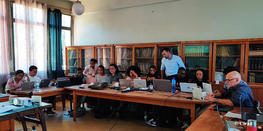This text is an English translation of the blog originally published in French on the website of MAKIS
A hackathon for the analysis of data from the MAKIS project
An introductory training course in R software was organized from January 29 to February 2, in close collaboration and co-financing with the Forests and Biodiversity Partnership System (dP F&B).
In order to make the most of the survey data collected as part of the MAKIS project, a hackathon combined with introductory training in R software was organized over 5 days from January 29 to February 2, in close collaboration and co- financing with the Forests and Biodiversity Partnership Scheme (dP F&B). The training was led by Angelina Rasoarinaivo, Julien Sarron, Bruno Bordron and Sergio Castro-Pacheco researchers at Cirad, with 12 participants from the MAKIS project (trainees, doctoral students, research assistants and researchers from Cirad and FOFIFA), among the 15 participants. This workshop aimed to acquire basic skills in the R programming language and the direct analysis of data collected in 2023 by the MAKIS project teams.
Participants first covered the basics of the R language and RStudio for descriptive statistical analyzes and modeling. Then, the training focused on exploring multivariate analysis techniques, including methods such as PCA, ACM, CAH.
On the last day, a transition to a “hackathon” was made, with the aim of directly analyzing the project data, in particular those of results R1, R2 and R3. For example, from the data from result R1, an initial analysis of the sources of household income by region was carried out using a Principal Component Analysis (PCA). This analysis made it possible to identify interesting patterns in the composition of agricultural activities contributing to household income. The Vakinankaratra and Itasy regions appear to share some similarities in their revenue sources, while Androy and Analanjirofo are distinguished by different compositions. This preliminary result led the MAKIS result R1 team to review its strategy for characterizing the socio-economic situation of households in its survey protocol.
Thanks to the hackathon, participants put into practice the knowledge acquired during the training. Furthermore, they have engaged in a collaborative data analysis process which will continue during the implementation of the project activities.
The positive feedback from participants highlights the immediate impact of this training on their professional practices, highlighting in particular the effectiveness of the hackathon approach.
|
|
|





